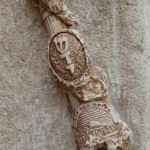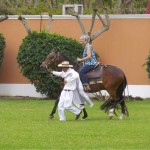by HF Mystery Writer | May 13, 2015 | Countries I Write About, Craft of Writing, Indie Author Blog
 Food - what the locals are eating.
Food - what the locals are eating.
photo of picarones cart in Mira Flores, Lima, Peru
“Tell me what you eat, and I’ll tell you what you are.” Frenchman Brillat-Savarin believed that food had its own story to tell. I agree. Writing, travel and food come together in providing a snapshot of a culture. Eating what the locals eat is the first step in appreciating who they are.
Benny Goldfarb, Private “I” has descriptions of what characters are eating in Colombia. My colleagues often tease me about a chapter making them hungry. That is an unfortunate side effect. I believe that by sharing the same cuisine, I move toward greater cultural appreciation. Speaking the same language also has a similar result. There are concepts couched in speech that have cultural nuances.
What might a citizen of Lima feel on a weekend afternoon in Kennedy Park when enjoying freshly-made picarones, a doughnut-like treat? There’s one way to find out—get in the line at the kiosk, and wait your turn. You will know what generations of Peruvian parents and children have relished.
by HF Mystery Writer | May 9, 2015 | Countries I Write About, Craft of Writing, Indie Author Blog
 Looking Inside a Book’s Main Character.
Looking Inside a Book’s Main Character.
Is Benny Goldfarb, the protagonist in Benny Goldfarb, Private “I”, a Jewish character or a character who happens to be Jewish? He is a man with a moral sensibility and an appreciation of how that happened.
In writing, characters demonstrate who they are through behavior and their reaction to events. In general, we don’t know the religion of the protagonists in the books we read. However, when someone has a name like Benny Goldfarb, an assumption occurs. If the reader makes that assumption, why not satisfy the curiosity—not as the focus of the work but as an interesting detail.
Why should the majority of detective/action/adventure characters have Anglo-Saxon or French names? In this case, Benny Goldfarb is an American who works as a private investigator. In truth, he cannot escape the perception of his ethnicity. In the story, his thoughts and feelings are shaped by his tradition and religious beliefs.
A visit to the Palace of the Inquisition in Cartagena, Colombia transforms Rosa Zuleca, the main female character, when she confronts the effects of the Spanish Inquisition on her family. Although this theme is a subplot, it adds depth to the story by introducing a setting where history, injustice and an individual’s identity meet.
by HF Mystery Writer | May 7, 2015 | Countries I Write About, Craft of Writing, Indie Author Blog
 History and Tradition – photo of Paso Fino
History and Tradition – photo of Paso Fino
When is a horse not a horse? When it’s a Paso Fino. Peruvian respect is profound for a breed of horse unique to the nation. The small, sturdy, smooth-gaited horse improved travel over long distances in mountainous terrain. Hacienda owners loved the Paso Fino. Why is this notable to me as a writer? The animal is a physical representation of social class. If I write about Peruvians, I should consider where someone fits in the power and economic structures of the country. The issue is part of the realistic detail that benefits the believability of fiction.
James Michener, in Hawaii, does that very thing. The development of his characters occurs within the context of where they fit in a tribal society meeting the modern era. The writer can show who characters are, not only by what they say and feel, but also by their social position.
by HF Mystery Writer | May 6, 2015 | Countries I Write About, Craft of Writing, Indie Author Blog
 Experience - photo of Cape Horn
Experience - photo of Cape Horn
What’s it like to round the Horn? For me, the experience was extreme. In the space of two hours, there was rain, hail, high winds, snow and sunshine. How did this affect me as a writer? I understand why the Bounty’s crew mutinied. In the movie, Captain Bligh informs the crew that he is taking them back to England by way of Cape Horn. The crew protests, “No, not the Horn!” Shortly after, they seize the ship and turn back to Tahiti. After experiencing the Horn, I would have joined them. Who wouldn’t? Half the ships rounding the horn foundered on the rocks. Their descendants inhabit southern Chile.
Nordhoff and Hall, the authors of Mutiny on the Bounty, traveled to Tahiti. The story benefited from their experience. Their research included perusing Captain Bligh’s journals, the ship’s log and historical accounts. The rich detail in a work of fiction is a thing of beauty.
by HF Mystery Writer | May 5, 2015 | Countries I Write About, Craft of Writing, Indie Author Blog
 Geography – photo of Ecuador
Geography – photo of Ecuador
Everyone has to be somewhere. Is that too obvious? Not to me as a writer. I feel an obligation to help the reader imagine the setting. The geography affects the ease or difficulty of movement. The flora, fauna and weather contribute to a sense of environment.
The Andes shape the use of South American countries. They are a barrier running down the interior of the nation. If you are wealthy, the range is something to be flown over. If you are not-so-rich, the bus trip can take days, or longer if landslides block the road. The isolation of the Incas and other native groups helped them evade the Spanish conquest. Native cultures still flourish at high altitudes. In Benny Goldfarb, Private “I”, the protagonists travel into the interior of Colombia. The detail of the story almost demanded the inclusion of a native group. In this case, the Paez tribe provides another point of view in Colombian society.
by HF Mystery Writer | Apr 28, 2015 | Countries I Write About, Craft of Writing, Indie Author Blog
 Culture - photo of Buenos Aires
Culture - photo of Buenos Aires
I have been to Argentina twice. I love the country’s physical beauty, the friendliness of the people and the food. Travel gives me an advantage. I have experienced the reality of how things are. I can incorporate the detail in my story.
Currently, I am finishing the second book in the Benny Goldfarb, Private “I” series. The setting is Argentina, Brazil and Paraguay. While I constantly research as I write, the experience of being there adds depth to the quality of the writing.
Argentina, like other countries in South America, has a colonial history. The architecture reveals something about the culture. The country still has close economic and social ties to Spain. However, Buenos Aires, like Brasilia, has a fascination with modern architecture. The Puerto Madero neighborhood, built on land reclaimed from the Rio de la Plata, breaks with the past in its physical footprint. Who are the Porteños, as citizens of Buenos Aires call themselves? They are romantic. They invented the tango. They take time out to have drinks with family and friends. They eat the best beef in the world. They love horses and futbol. They have a mythic figure, the gaucho. They have a history of turbulent national politics and corruption.
As I write my story, I try to paint the characters with my understanding of what is normal in their world. I believe the reader appreciates the nuances in the portrayal. Even if the reader hasn’t been to Argentina, he or she can catch a glimpse. I love it.
by HF Mystery Writer | Apr 28, 2015 | Craft of Writing, Indie Author Blog
 On writing.
On writing.
Writing is like painting. There has to be something there to hold your attention, something that makes you stay and look. Not everyone likes Picasso, and not everyone likes Rembrandt. My guess is that neither Picasso nor Rembrandt cared what people thought, or they would have had to take a poll before finishing a painting. So it is with writing. It’s better not to care about what appeals to potential readers. Just go with what you like. Kindred souls will find your work—eventually.
Should you write what you think will sell in the current marketplace, or do you write about what interests you? For me, enthusiasm for the subject is a basic ingredient. That can only come from personal interest or inspiration. After all, your creativity is your contribution to the art. This blog is a continuing essay about the way I see writing.
 Food - what the locals are eating.
Food - what the locals are eating.





